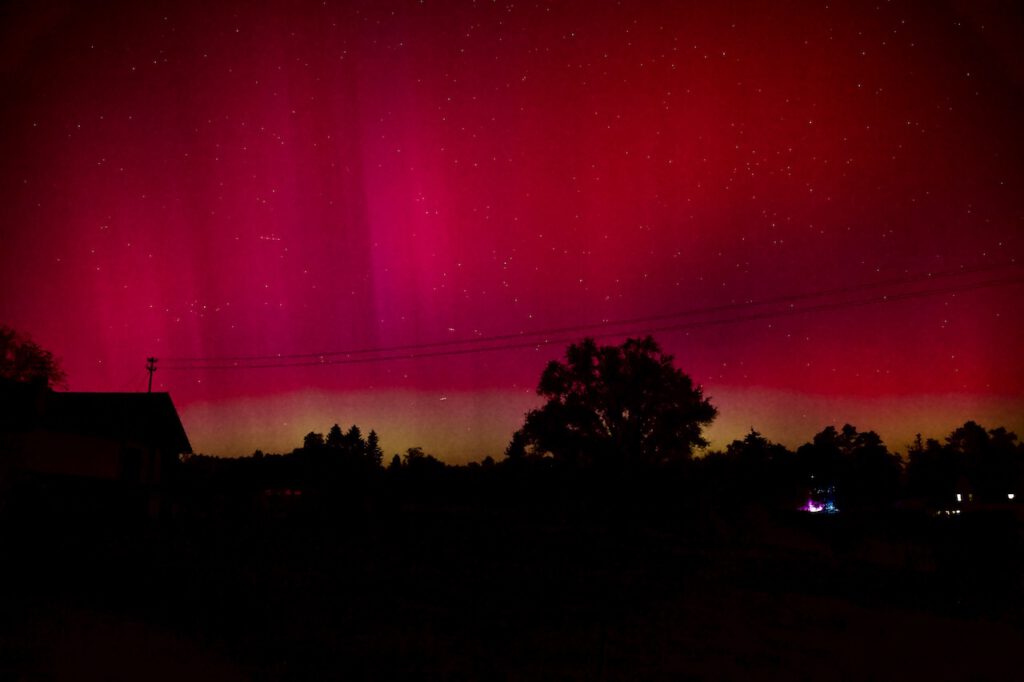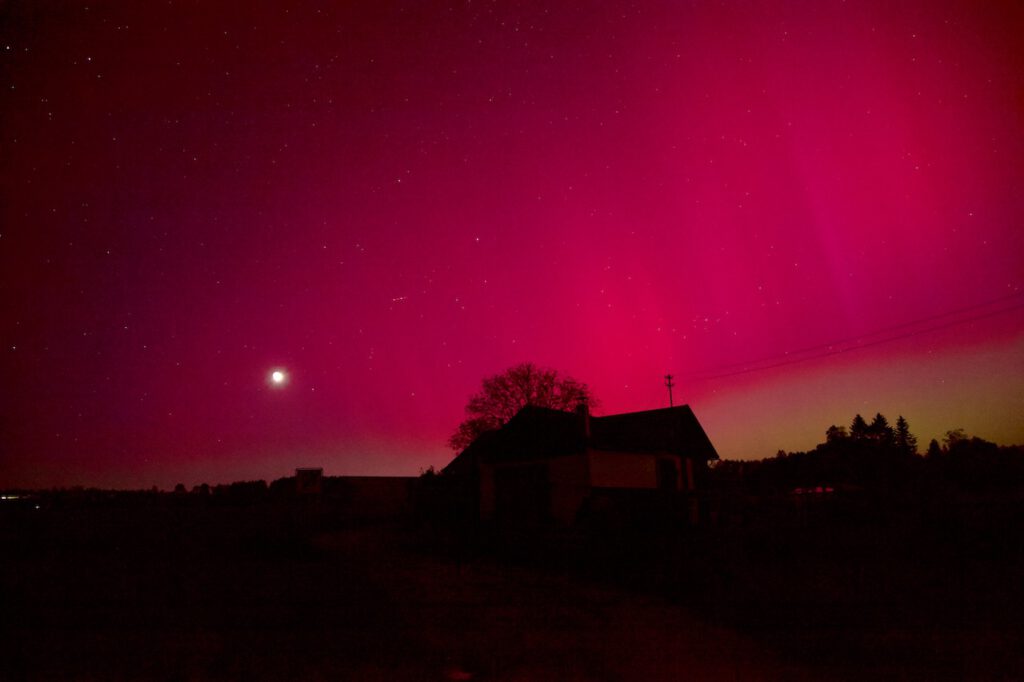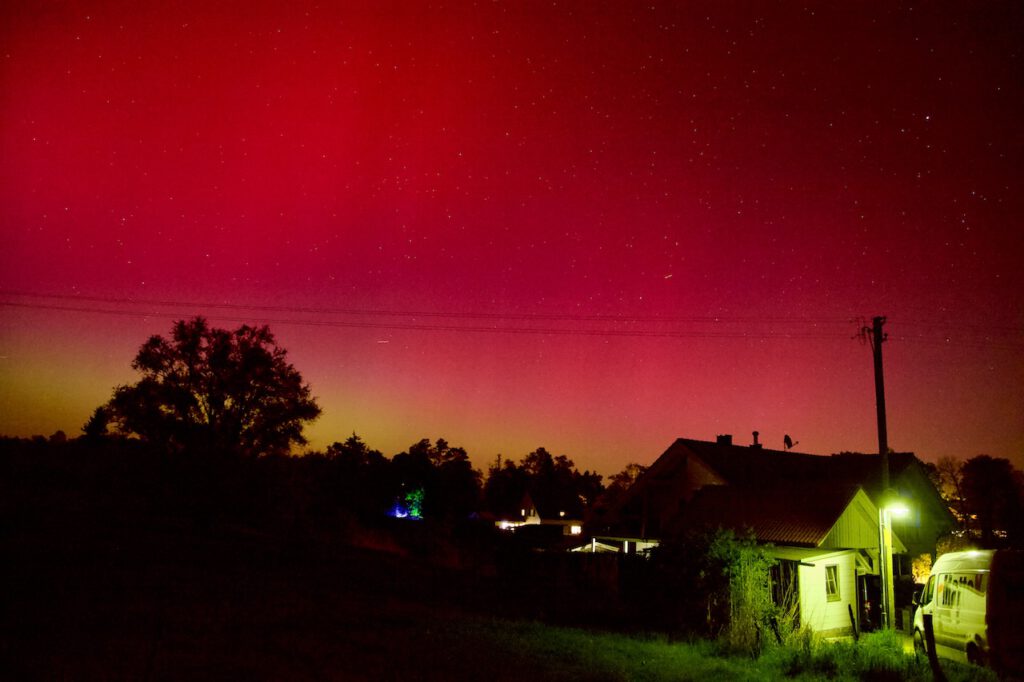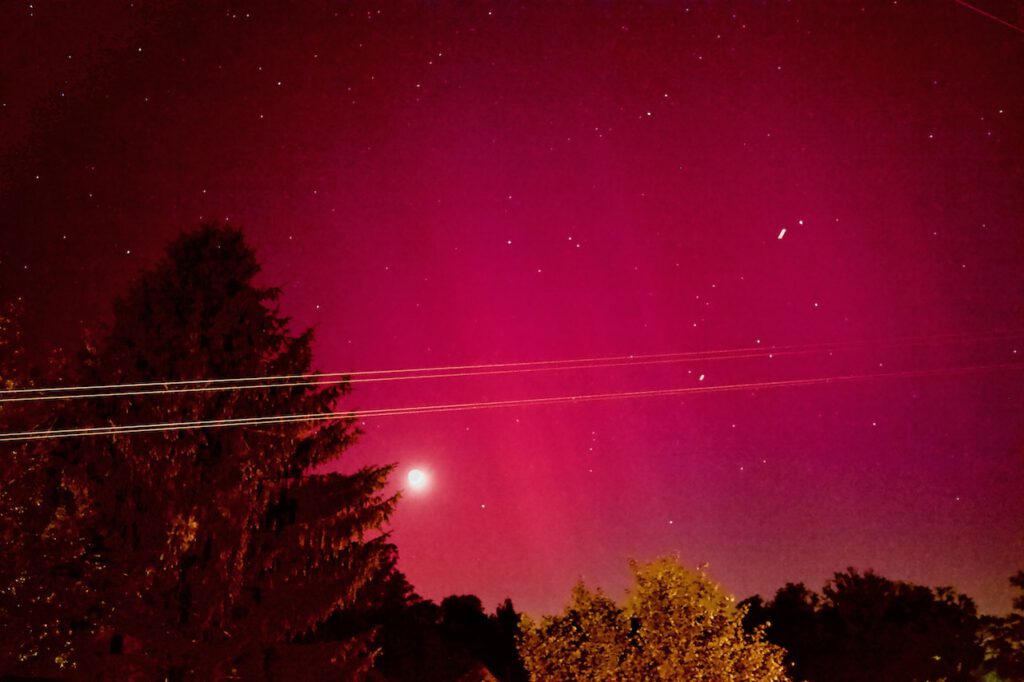Seltener G5-Geosturm und Nordlichter am 10. Mai 2024
Peter Engelmann, 18 Mai, 2024
Am Freitagabend, dem 10. Mai 2024, ging für viele Menschen ein Traum in Erfüllung. Aurora Borealis, das geheimnisvolle Nordlicht, war zu sehen. Ein außergewöhnliches Sonnenereignis machte es möglich.
Das Nordlicht erschien nicht nur in den nördlichen Breitengraden, sondern an vielen Orten weltweit, von San Francisco über die Dolomiten in Italien bis nach Lviv.
Stärkster Sonnensturm seit Jahrzehnten
Der Grund dafür war der intensivste Sonnensturm seit Langem. Eine Flut von CMES (Coronal Mass Ejections) und Sonneneruptionen schoss Wolken geladener Teilchen und Magnetfelder auf die Erde. Dies führte zum stärksten Sonnensturm der letzten zwei Jahrzehnte und erzeugte laut NASA wahrscheinlich eines der stärksten Polarlichter der letzten 500 Jahre. https://science.nasa.gov/science-research/heliophysics/how-nasa-tracked-the-most-intense-solar-storm-in-decades/
Laut NASA war dieser Sturm so stark, dass er nur von den berühmten Ereignissen von 1958 und 2003 übertroffen wurde. Das Space Weather Prediction Center der National Oceanic and Atmospheric Administration warnte vor dem bevorstehenden Sturm, weil Sonnenstürme Satelliten und Stromnetze ernsthaft beeinträchtigen und die Gesundheit von Astronauten gefährden können. Anders als beim Carrington-Ereignis (https://en.wikipedia.org/wiki/Carrington_Event) wurden jedoch keine ernsthaften Ausfälle oder Schäden gemeldet.
Deshalb wurde dieser spektakuläre Geosturm zu einem Ereignis für begeisterte Naturliebhaber, Wissenschaftler, Fotografen und Filmemacher. Da Mobiltelefone lichtempfindlicher sind, zeigen sie die Polarlichter besser als das bloße Auge. Darüber hinaus demonstrierten uns die mit Mobiltelefonen aufgenommenen und in den sozialen Medien geposteten Bilder die große Vielfalt des sich ständig verändernden, surrealen Nordlichts.

Das außergewöhnliche Ereignis ist auch von wissenschaftlichem Wert. Es lieferte den Forschenden äußerst wertvolles Material, das sie nun jahrelang untersuchen werden. Die NASA sammelt die von Enthusiasten rund um den Globus aufgenommenen Bilder für die Forschung (https://aurorasaurus.org/).
Der Sturm erreichte die höchste Stufe G5 und ereignete sich inmitten der größten Aktivität während des 11-Jahres-Zyklus der Sonne. Auch Astronom:innen beobachten schon seit Monaten riesige Sonnenflecken.
Wie kann man erfahren, ob Aurora Borealis auftritt?
Das außergewöhnliche G5-Ereignis hat das Interesse vieler Menschen geweckt. Wer die Nordlichter verpasst hat, würde sie gerne bei der nächsten Gelegenheit sehen. Eine Möglichkeit, sich auf dem Laufenden zu halten, ist die Weltraumwettervorhersage und ihre 30-Minuten-Vorhersage für Polarlichter (https://www.swpc.noaa.gov/products/aurora-30-minute-forecast). Um die Seite richtig zu verstehen, muss man vielleicht etwas recherchieren, aber es gibt zahlreiche YT-Videos über Polarlichter. Ihr dürft diese Vorhersagen allerdings nicht mit der Wettervorhersage vergleichen. Im Unterschied zur Meteorologie ist die Weltraumwettervorhersage relativ neu und es gibt nur wenige Messinstrumente. Die Wissenschaftler:innen sind noch dabei zu lernen. Ihr solltet also am besten ein wenig Geduld mitbringen. Ich empfehle auch, regelmäßig Astronomieforen in sozialen Medien zu lesen.
Und woher wisst ihr nun, dass bei euch ein Polarlicht auftritt? Lohnt es sich, mitten in der Nacht loszufahren oder sich zu Fuß auf den Weg zu machen? Ich kann nur berichten, was ich gemacht habe: Als ich von der Möglichkeit erfuhr, habe ich alle 10 Minuten eine Foto-Webcam-Seite auf meinem Computer überprüft. Ich habe das Polarlicht zuerst auf der Zugspitz-Webcam in Bayern entdeckt. Es lohnt sich, auf Webcams zu achten, die nach Norden ausgerichtet sind. Denn in der nördlichen Hemisphäre sieht man Polarlichter normalerweise am Nordhimmel (und umgekehrt in der südlichen Hemisphäre am Südhimmel).

Was sind die Voraussetzungen für die Beobachtung von Nordlichtern?
Natürlich muss es dunkel sein. Nicht komplett, aber man braucht einen dunklen Himmel. Der 10. Mai war ideal, weil der Mond zwar da war, aber es war kein Halb- oder Vollmond. Auußerdem braucht man einen meist klaren Himmel. Es gibt auch gute Möglichkeiten, sehr kreative und beeindruckende Bilder mit ein paar Wolken oder einem Gewitter zu machen. Ihr müsst jedoch wissen, dass Nordlichter nicht durch Wolken hindurch leuchten. Aufnahmen mit Nebel oder Staub funktionieren also nicht, ebensowenig wie ein verschleierter Himmel mit einer Strato-Nimbus-Wolkenlandschaft. course, it has to be dark.
Wo kann man die Nordlichter beobachten?
Viele Menschen machen teure Reisen nach Norwegen, um den Nordhimmel zu sehen. Wir interessieren uns hier aber für die Frage, was ihr machen könnt, um den Nordhimmel – im Idealfall – in eurem Ort zu beobachten?
Zuallererst: Sucht euch einen dunklen Ort. Handybilder lassen die Nordlichter heller erscheinen als sie sind. Fast alle verwenden lange Belichtungszeiten. Unabhängig davon ist es natürlich auch schon ein großartiges Erlebnis, sie überhaupt mit bloßem Auge zu sehen. Es ist durchaus möglich, Nordlichter in Großstädten zu sehen; ich habe das erste Mal im Jahr 2000 ein rotes Nordlicht mitten in Berlin gesehen. Aber je dunkler der Himmel ist, desto besser. Ein Feld, ein Berg oder ein Küstenabschnitt sind großartig (man muss nicht unbedingt auf eine größere Höhe gehen, aber natürlich sind die Bedingungen dort oft besser, weil die Luft sauberer und weniger staubig ist). Wenn ihr in die Natur geht, ist eine Taschenlampe wichtig. Astronom:innen verwenden oft einen Rotfilter vor der Lampe, da sich die Augen an die Dunkelheit gewöhnen müssen, um besser zu sehen, und rotes Licht weniger störend ist. Nehmt euch Zeit, um euch an die Situation anzupassen.
Ein weiterer Punkt, der wirklich wichtig ist, ist ein freier Horizont, insbesondere ein freier Nordhorizont. Wenn ihr einen See in der Nähe habt – perfekt! Geht an das südliche Ende des Sees und schaut nach Norden.

Wie fotografiert man Nordlichter?
Es gibt unzählige Anleitungen, und wenn man mit der Qualität von Handyfotos zufrieden ist, ist es ganz einfach. Natürlich ist ein Stativ oder ein stabiler Stand eine wichtige Voraussetzung.
Ich habe keine Allround-Anleitung oder spezielle Richtlinien. Meiner Auffassung nach ist die wichtigste Frage, was ihr mit euren Bildern erreichen wollt. Möchtet ihr realistische Bilder oder einen eher künstlerischen, faszinierenden, vielleicht sogar psychedelischen Eindruck? Wollt ihr nur die Nordlichter im Bild haben oder einen interessanten Vordergrund, eine besondere Komposition? Die Möglichkeiten sind endlos.

Wenn ihr eine bessere Qualität anstrebt, ist eine größere Kamera von Vorteil. Im Idealfall setzt ihr ein lichtstarkes Objektiv ein. Ich habe Blende 2,8 bis 4 verwendet. Natürlich sollte man den ISO-Wert erhöhen, aber es ist nicht nötig, ihn voll auszuschöpfen. Die Nordlichter sind oft stark genug und man kann unnötiges Rauschen vermeiden. Ich habe gehört, dass Belichtungszeiten von 20-20“ Sekunden empfohlen werden. Ich habe zwar kürzer belichtet (um den Preis, dass mein Bild etwas verrauscht war), aber es kommt immer auf die Situation an. Denkt daran, dass bei Belichtungszeiten von mehr als 30 Sekunden die Sterne oder der Mond aufgrund der Erdrotation Streifen bekommen. Ich habe kürzer belichtet.
Wichtig ist, dass man auf den Fokus achtet: Bei manchen Kameras funktioniert der Autofokus bei Dunkelheit nicht richtig! Ich habe die Brennweite auf nahezu unendlich eingestellt, nachdem ich einige unscharfe Bilder gemacht hatte.
Wirklich wichtig ist es, wenn möglich in RAW zu fotografieren.
Es gibt eine interessante Sache bei Nordlichtern: der Weißabgleich. Manche Leute sagen, dass der Weißabgleich bei 4000 K liegen sollte, aber ich habe festgestellt, dass die Aurora Borealis eine einzigartige Lichtquelle ist. Wenn ihr im RAW-Format fotografiert, könnt ihr in der Nachbearbeitung mit Weißabgleich, Farbton und Sättigung spielen und so die besten Ergebnisse erzielen. Ich möchte euch dazu ermutigen, dies zu tun und das volle Potenzial der Bilder auszuschöpfen.
Ein letzter Tipp: Da die Aurora Borealis oft schnell erscheint und sich ständig verändert, ist es gut, die richtigen Einstellungen vorzubereiten und so viele Bilder wie möglich zu machen. Hier gibt es eine große Vielfalt.
Die Diashow zeigt verschiedene Facetten des Gewitters vom 10. Mai:
© Deutsche Übersetzung: Susanne Niemuth-Engelmann / Redaktionsbüro Niemuth, https://redaktionsbuero-niemuth.de/ / 28.01.25